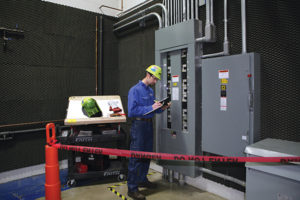11.03.2015
Faith Technologies Rolls Out Energized Work Process
 Faith Technologies is occasionally requested to perform energized work for our clients and customers, so recently we rolled out an energized work process to adequately educate our employees on what constitutes energized work, justifications to perform energized work, and how it could be safely performed. Understanding the process, if and when these tasks arise, is very critical in maintaining the safety and well-being of our employees and customers.
Faith Technologies is occasionally requested to perform energized work for our clients and customers, so recently we rolled out an energized work process to adequately educate our employees on what constitutes energized work, justifications to perform energized work, and how it could be safely performed. Understanding the process, if and when these tasks arise, is very critical in maintaining the safety and well-being of our employees and customers.
Quite often, employees get confused about what constitutes energized work. We want them to understand that working “on, in or near” live motor control centers (MCC), switchgear sections, or any energized equipment constitutes an energized work, and presents a clear and present hazard to their well-being.
It is important for workers to understand that not being exposed to energized parts does not constitute a “safe condition.” A section of equipment could have no energy source, but if the potential exists for an arc flash, the employee is not working in an “electrically safe” condition.
An arc flash risk assessment is performed prior to performing work in order to determine if an arc flash or any other hazard exists. Choosing to not de-energize the equipment has a potential for electrocution, arc flash, and arc blast. Therefore, the safest method to work “on or near” any electrical equipment is to de-energize the equipment and control all hazardous energy. At Faith Technologies, we do this through our lockout tag-out (LOTO) policy.
When it comes to making a justification for energized work to be performed, our employees are also required to follow the three justifications stated in NFPA 70E 130.2 (A). This could include demonstrating that de-energizing the equipment is infeasible due to equipment design or operation limitation, introducing additional hazards or increased risk, or operating at less than 50 volts. If there is a justification for an energized work to be performed, an energized work permit must be filled out to ensure work is performed safely. Elements of the energized work permit include:
- A description of the circuit and equipment to be worked on
- Justification for why the work must be performed energized
- A description of safe work practices to be employed
- The necessary PPE to safely perform the work
- Means of restricting access to unqualified persons in the work area
- Proof of hazard communication between the supervisor, safety manager, project manager, client’s representative, etc.
Faith Technologies requires that all of these components must be present before work can proceed. In fact, in situations where work is to be performed on any energy source of 600V or over, our Electrical Risk Management Group Manager must authorize the work, otherwise it can’t be performed.
Ultimately, the safest method to work “on or near” any electrical equipment is to de-energize that equipment. However, if there is a justification for an energized work to be performed, it has to be done safely. Faith Technologies believes that this energized work process will educate and empower our employees and clients to make safe decisions in order to protect their lives.
If you enjoyed this blog article, please subscribe to stay up to date on the latest industry news from our experts at Faith Technologies.



